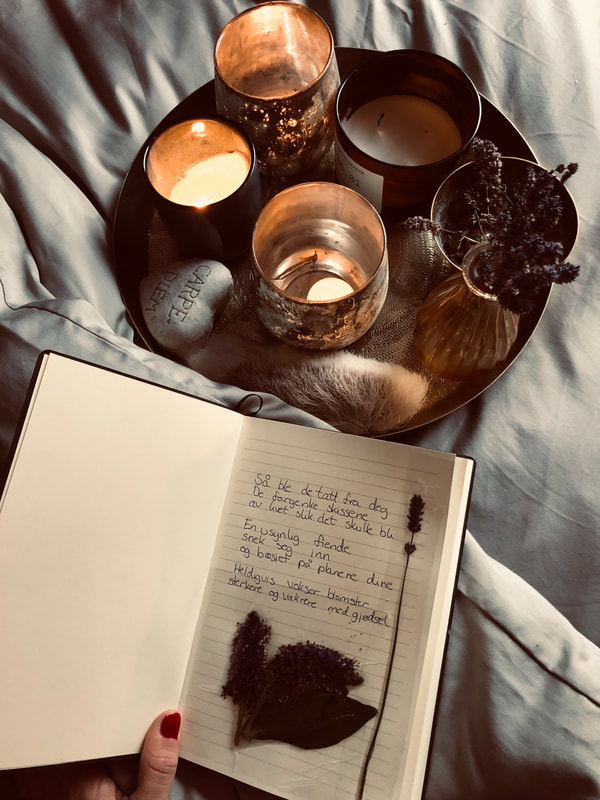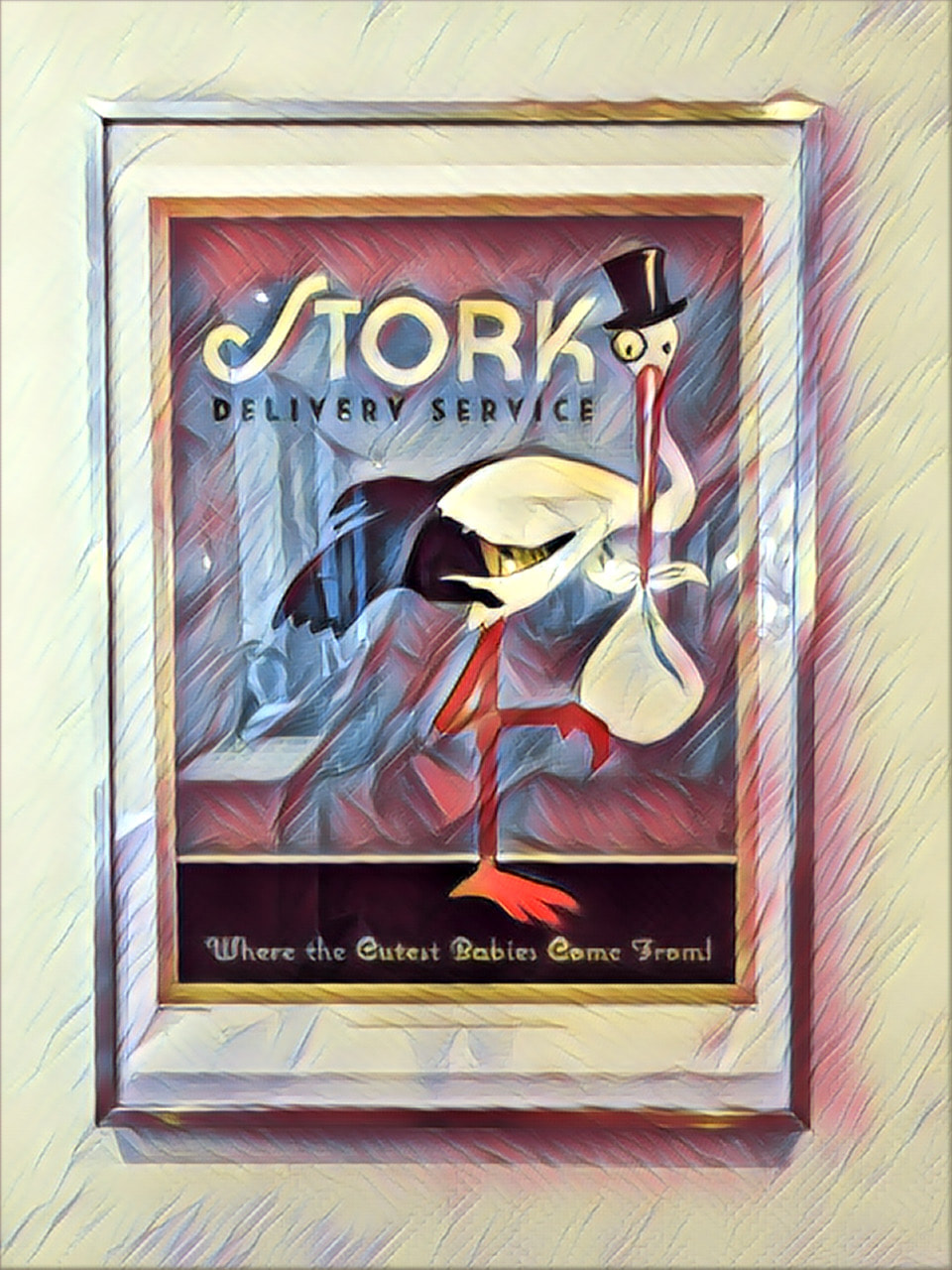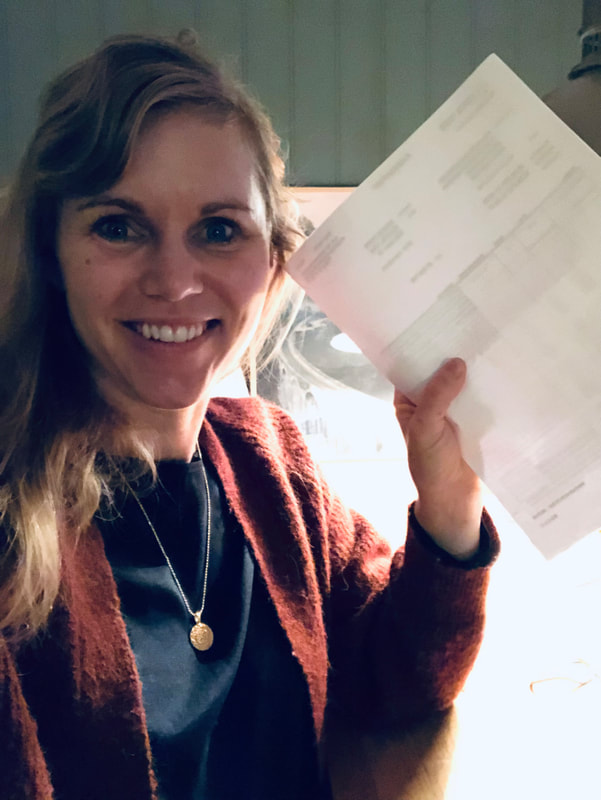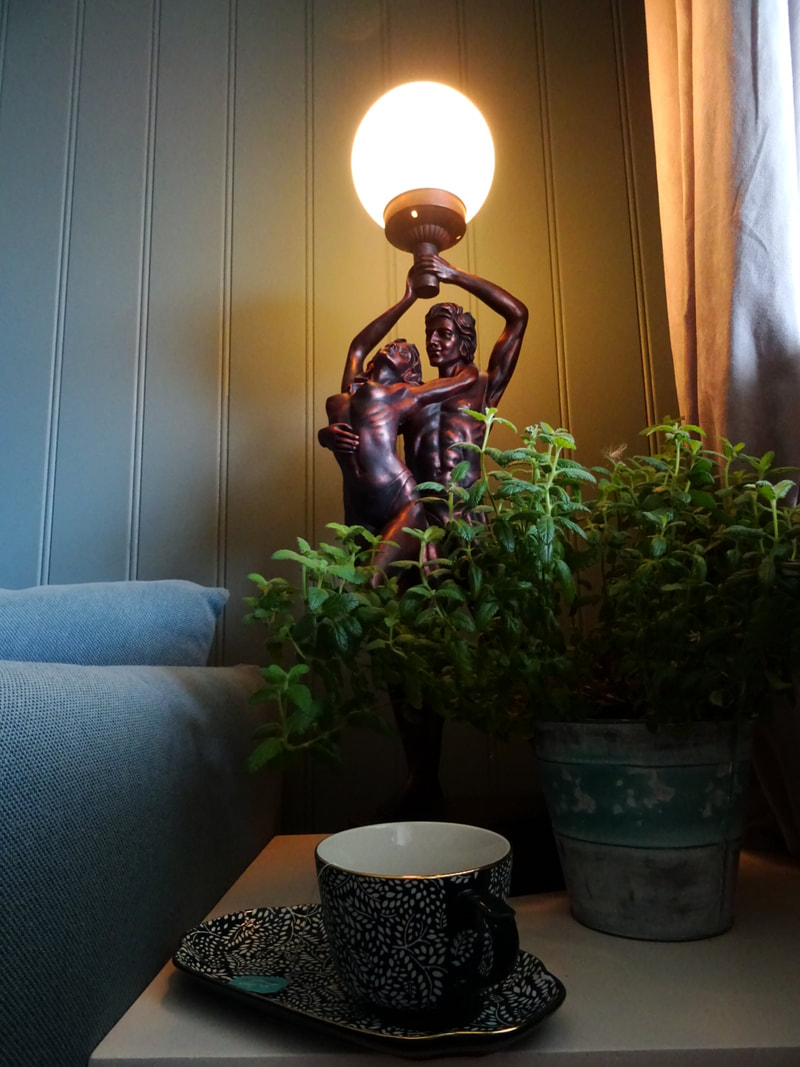|
I've always loved dressing up in costumes. When you put on a costume, it feels like you get acess to another part of your personality for a little while. Sometimes it can feel liberating to hide behind a costume. Allow a hidden side of yourself to come out. When you think about it, to some extent we put on costumes every day. We choose outfits and a part of our personality that's appropriate for the occasion. This weekend, the dark, gruesome and grotesque costumes are coming out. An innocent flirtation with the darker side that lives within all of us.
This year I feel like I have flirted with many new aspects of my own personality. Suddenly I'm standing here in October realizing that I am not quite the same person anymore, something has changed. A bit like the werewolf maybe? Both the butterfly and the wolf's connection to lupus is about the rash over the bridge of the nose and cheeks, but they are also good symbols for some of the involuntary changes you go through. The butterfly is a slightly prettier symbol of transformation. The werewolf, on the other hand, is perfect as a Halloween costume, because one thing that never changes, is the joy of dressing up for Halloween! So this year it had to be werewolf costume. Lupus can feel a bit like a werewolf curse. Last Christmas, I felt the physical ravaging particularly well throughout my body. The wolf was not kind and almost forced me into prayer in front of the pillbox in the morning. Being made aware of your own mortality in that way, does something to you. Feeling the fear that the pain would never end, but become permanent. It was a light bulb moment realizing how much self-confidence and self-worth one had put into work, hobbies and things one could usually do without a problem. If these things suddenly disappear, the fall will feel all the greater if one doesn't have a secure core of self-worth. To feel that you have a value even if you can't work for example. Fortunately for me, this painful period was short and I have so far been spared a recurrence of the pain. But the awe of how vulnerable life and the body are, is still there and has changed me. Hopefully to a better and more humble edition. A nice side effect that has accompanied the disease is a greater understanding and tolerance for all the things you can not tell from outside of another human being. Getting a chronic diagnosis is a bit like being uprooted to be replanted. Meaning you would rather be planted back in a more nutritious place, so the flower doesn't wither. The fact that the disease is triggered and triggered by something in the environment has brought with it a domino effect of thoughts about my life, how we live our lives, and how society wants us to live. The food we eat, how we treat the nature around us, what qualities and values we prioritize and value. One is forced a little to turn off habits, thoughts and actions that have been automated. Reassess and see if there is anything you should clean up, remove, or rethink. To those around you, it may seem that you have become strange and different. In reality, it's more about figuring out how to live your best life with an unstable trigger mechanism within the body. Where the wolf represents the pain, the hurt and the brutal lupus can do to your body and mind, perhaps the butterfly illustrates the slightly finer, inner change. Because you are forced to look inwards. Find the strengths and qualities you can use to cope with the new life. Be concious of the mental nourishment and information one chooses. It's not necessarily done in a jiffy, you may have to go through several stages. But once you get through the first stage, the next will be easier. I tell myself when I'm in need of a pep talk "You landed on your feet after 2020, you can handle this". It's said that if a butterfly struggles to get out of the cocoon, you shouldn't try to help it, because then it will die. It's the wear and tear of the cocoon that gives the wings enough muscle power to fly. It's a nice illustration that "wgat doesn't kill you, makes you stronger", but when you have lupus you quickly discover that it's not necessarily just a matter of giving a little extra, pushing a little harder or being better to escapethe cocoon. Sometimes time, calm and patience are the only remedy. It can be frustrating, but in return the view feels all the more beautiful the times you do get to fly.
0 Comments
There is something mysterious and magical about the moon. It runs in a cycle of 29 days and 12 hours. A cycle of forces. Just like an average menstrual cycle. The forces of the moon affect the tide, and some believe it affects us as well. Maybe not so strange, since we're made up of mostly water. And as the moon affects the water, the menstrual cycle affects us. If there is something you suddenly become focused on when you're trying to get pregnant, it is your cycle. You also get a newfound respect for how complicated and wonderful nature has put us together to be able to conceive a child. I don't really remember that we had that much sex-ed. Except for a short session of giggles in a science class, in middle school. Which is kind of sad, when I only now as a full grown adult understand how much we are affected both physically and mentally by each phase of the cycle and how intricate it really is.
Menstruation (days 1 to 5) The first day of the period marks the end of the previous cycle and the beginning of the next. The body gets rid of the layer of uterine lining that is supposed to catch the fertilized egg. The fact that you are bleeding and maybe a little tired with cramps and aches, makes it natural to take it easy. To take a little extra care of yourself the first few days. The level of estrogen and progesterone is low when the period starts. This is one of the reasons why you can feel a little emotional, down and grumpy the days just before and the first days of the period. Estrogen is linked to the production of serotonin, the "happiness hormone". The follicle phase (days 6 to 12). The follicular phase actually starts at the same time as the period. A follicle is a small bladder with a small egg. When the period comes, 3-5 follicles start to grow, of which 1 will eventually be the egg that is released. It's the hormone FSH that signals to the follicles to start growing. This is one of the hormones that is measured when starting fertility treatment and says something about the quality of the eggs. During day 5, a follicle has taken the lead and becomes the egg to be further developed. The rest disappear, ie you lose more than one egg during a cycle. In this phase, the estrogen level rises, and with it the mood and physical capacity also rise. This is the period when the body is at its peak physically, mentally and socially. Personally, I notice, for example, that during this period I am mentally tougher in the climbing gym. Taking chances comes naturally, and I feel stronger both physically and mentally. The energy level is generally higher and I have more stamina during this period. Receiving bad news, for example, is much easier to deal with. Ovulation (days 12 to 16) It's show time! The increasing estrogen is soon at its peak and eventually causes a significant increase in the LH hormone (luteinizing hormone). It's this sudden increase that is gives a positive ovulation test. For us without a partner, this is the time we get on the phone with the Fertility Clinic. The selected egg will now embark on its fated journey down the fallopian tube and hopefully meet up with a handsome swimmer on the way. When the egg is released, it has about 24 hours to be fertilized. The days around ovulation are the days when the woman is at her peak. It's said that you likely tolerate more pain and is at your most social and attractive. After all, the body is trying to make a baby, but if you're not trying for a baby, you can use these latent powers for something else. During these days, it feels a bit like surfing on a wave of green lights and absolutely nothing can go wrong. Luteal phase (days 17 to 28) When the egg is released, the follicle is released into something called the corpus luteum, which produces the hormone progesterone. This leads to a sharp increase in this hormone, which together with estrogen prepares the body to receive a fertilized egg. The lining of the uterus thickens again and the temperature in the body rises. The body gets into incubation mode and creates a thriving environment for the egg. Progesterone is a hormone that is often used after an IUI (Intrauterine insemination) to increase the chance that the egg will attach to the lining. As I have understood from my rheumatologist, it's not common that this hormone triggers lupus. Eight to nine days after ovulation, hormone production begins to decline. The falling hormone levels are linked to the mood swings associated with PMS. For my part, this is when I tend to ponder and become philosophical, while overthinking everything, with a side of melancholy. When there is no fertilized egg, the corpus luteum will eventually be destroyed. With this abrupt stop of hormones, aunty flow makes an apperance, and a new cycle begins. My experience is that knowing your own cycle and knowing how it feels and behaves in your own body is useful knowledge. Both to recognize the abnormal and to be able to give yourself some slack in certain periods. It doesn't have to mean you have to limit yourself based on the different phases, but it's an opportunity to utilize the potential that lies within the cycle. At the same time, it's also a comfort to know when it suddenly feels like the world is falling apart, or when you are moved to tears while matching single socks with each other, it could be a natural and hormonal explanation. Sources: https://sml.snl.no/menstruasjon https://www.vilbligravid.no/fertilitet/kvinnens-fertilitetsutredning/ https://www.everydayhealth.com/womens-health/how-your-menstrual-cycle-affects-your-behavior.aspx It's Thursday morning at Gardemoen. A steady stream of people flows through the security checkpoint. With a flustered expression, I try to sort the suitcase, PC, liquid, jacket and shoes on the moving belt. "The beanie" the guard nods towards the belt. Ah, yes, I had forgotten it. Throw it on top the jacket. Ready. "You got liquid in the bag?" No ... ah shit, I forgot to empty the water bottle. I move through the metaldetector - piiip, random check. The guard gives me a smile and sweeps for traces of drugs on my hands and waistband. Then it's time to gather everything back together quickly and swiftly, without taking up space or being a nuisance to the next person in line. Is there one place you need to know what you're doing, it's at the airport. It's a small universe of social codes and norms. Countless chronicles have been written by smart, well-traveled and annoyed people about proper airport etiquette. An important point on the list is not spend too much time in the security check. Ideally, you should be through so quickly that no one even noticed you were there. As I finally get through to the other side, I fell sweat trickling dawn my back and a little flustered.
The last time I was at Gardemoen, both me and the airport were a lot calmer. I was on my way to Copenhagen and the Stork clinic. The tension in my chest was linked to something completely different than it is today. Today I am on a work related trip and have put on my work persona. With a slightly nicer jacket and boots, I try to cover up the slightly insecure girl who doesn't feel in control today. Serious faces swirl around me. They look so professional, as if they have everything taken care of. Maybe they're actually a little stressed inside too? It has somehow been part of my job identity to be conscientious and efficient. Now this job persona has started to crack at the edges. Where I used to have a large work capacity, I now get stressed more easily. These days it doesn't take much before things starts to feel fussy and tiring. After buying an overly expensive coffee with pumpkin spice and filling tmy water bottle with lukewarm water from the restroom, I'm at the gate. I've been feeling well for a long time, so I'm not really worried that I'll suddenly get very sick trip. But I'm still a little anxious about how my energy level will hold up. In these kind of work contexts, there is less room for mental rest compared to a normal working day. Representing the workplace externally requires being a little more "powered up". The fact that everyone will give a small presentation is also stressing me a little. Even though I have met most of the participants before. It's strange that a few minutes of presentation steals so much mental energy and thought activity. I take a deep breath and lower my shoulders. Take a sip of the spicy coffee and remind myself of what I have tackled this year. So what if the powerpoint slides and the presentation isn't perfect, it really isn't the end of the world. After filling up my pill box for the week, it became clear that it was time to stop by the pharmacy to stock up on Imurel and prednisolone. Since the grocery store has an offer on my fave coffee this week, I made sure to beat two birds with one stone. After grabbing grabbing a couple of bags and heading towards the check-out, I bump into a familiar face from high school. In his trolley a cute kid and he tells that number 3 is on its way. We chat a little loosely of this and that. He's aged well. Only a few wrinkles around his eyes reveal that he is in the middle of raising small kids. There is something nice about coming from a small town where you can suddenly stumble upon old acquaintances in this way.
Rewind back to March and I would have done anything to avoid suddenly bumping into old familiar faces. Especially handsome guys from high school. It would've sent me straight into the comparison trap and a trip down to the dark side. The voice in my head would've pressed all the painful buttons and intensified the feeling of loss, sadness and loneliness. The question "how are you?" would lead to blank lies and flickering eyes. Most likely I would have tried to avoid it all together and tried to make myself invisible. Maybe stuck my head down the freezer and examined the table of contents on a packet of salmon. Today I'm trying to be invisible. When I answer that all is goodl, I can feel physically in my body that I actually mean it. My smile is real and my voice is steady. That I'm gesturing with a pharmacy bag in my hand, I only register afterwards. There is a completely different calmness in my body now, compared to March. It no longer feels like I'm trying to fight the situation, but have accepted it as it is right now. Coffee, the black morning gold! The smell of freshly ground beans or freshly brewed coffee is just fantastic. Whether it comes in a thermos, a cup or in a glass of steamed milk, coffee is definitely an important part of the morning ritual. Enjoying a cup of coffee while staring blankly out the window, or deep into a crackling fire is just lovely. But more often it's consumed while choking a yawn and rubbing your eyes by the coffee machine at work. When I tried to get pregnant last year, I cut out coffee, and the morning was not quite the same with decaffeinated alternatives. Not mye head either for that matter, the caffeine abstinence felt quite loud until I got used to it. When the pregnancy plans were put on hold, it did not take long before I was back on the coffee and I easily drink 3-4 cups before lunch. After lunch, my inner coffeewench is usually satisfied. But if it's a special occasion she can handle a cup or two in the afternoon.
One might think that coffee and caffeine were something to avoid when you have lupus, but a study indicates that coffee can actually have a positive effect on lupus. It may not be based on as many patients (89), but patients with low caffeine intake had more frequent manifestations and were more often treated with cortisone. Those with high caffeine intake also had lower levels of cytokines. Cytokines are involved in the regulation of the inflammatory response. There are several types of cytokines, some of which are associated with increased disease activity in lupus. Those who had high coffee intake had lower levels of these cytokines. Now, I don't have access to the study itself, only the abstract and the conclusion, so I did not see what was defined as high and low intake. Something similar has been seen when it comes to cardiovascular disease. Compared with those who drank 0 cups a day, those who drank 3.5 cups daily had a 15% lower risk of cardiovascular events. Those who drank 5 cups had 5% less risk. So I really see no reason to cut that delicious, black, morning gold just yet. Kilder: https://www.lhl.no/sunnere-liv/ernaring-mat-og-helse/kaffe-hjertehelse-og-kolesterol/ www.lupus.org/news/first-study-to-assess-the-impact-of-caffeine-on-lupus-disease-activity-steroid-use-and-other journals.sagepub.com/doi/abs/10.1177/0961203320941920?journalCode=lupa arthritis-research.biomedcentral.com/articles/10.1186/ar3349 https://www.emjreviews.com/rheumatology/article/cytokines-and-inflammatory-mediators-in-systemic-lupus-erythematosus/ Putting thoughts and feelings into writing has been form of therapy. Trying to see it all from the outside, as if it were a scene from someone else's life. By describing the environment or the feeling from the narrator's perspective, I somehow get to see and process it from a different angle. Emotions or thoughts that I am ashamed flows more freely and become a little less scary this way. In the weeks following the diagnosis, there were many such small stories and scenes that came to life for a little while. Sometimes in the form of poems. Some are deleted, some are allowed to live on, on the harddrive. Whether they exist anymore or not is not important. The most important were the cathartic moments where the words flowed freely and uninhibited.
Putting your thoughts into words by writing them down or saying them out loud makes it easier to see them objectively. Negative thought spirals are easier to detect and stop when you see the words written down or hear yourself say them out loud. The inner critic gets a little less power when the words are forced into the light, rather than buzzing unchallenged in the background. Sometimes I end up having to laugh out loud when I see / hear how silly they are. Other times I can't read through afterwards. Then I just press delete or burn the sheet afterwards. But just getting it out of your head makes it easier, reduces the pressure. Writing as therapy works in several of life's more difficult aspects, such as chronic pain, divorce or treatment of substance abuse. I usually write digitally. It's easy to erase, reformulate or delete. Plus it's a lotfaster. In a way, there is an opportunity for retreat in a digital document. But at my bedside table lies a lined book, bound in blue imitation leather. An orange rubberband protects it. As a nice contrast against the blue. The idea was to use it as a gratitude journal or for personal scribbling, but I find it difficult to break the first page. Writing by hand on paper gives a special feeling, more personal in a way. Handwritten letters and cards are rarely sent these days, but oh so nice to receive. Words on paper capture emotions in a different way. Think how much more dramatic it is to burn a letter than to delete an email. For this reason, it feels like there should be written something important or nice on the first page of a blank, unwritten book. The first page of the blue book has been blank for a long time, but today I break it with a poem I wrote 10 days after I became ill. And at last the first blank page is finally broken. Source: www.psychologytoday.com/us/blog/psychiatry-history/202011/how-expressive-writing-works https://www.psychologytoday.com/us/blog/write-yourself-well/201208/expressive-writing https://psykologtidsskriftet.no/fra-praksis/2017/09/skrive-livet https://axialspondyloarthritis.net/living/journaling www.sciencedaily.com/releases/2017/05/170508162304.htm Deciding to become a mom on your own is not an easy or easy decision. You must simply and easily consider whether it is something you want and can do alone. Even if you have a large and good network around you, you must be equipped to do the job. Perhaps the most difficult and painful thing is to let go of the family dream and realize that life took a different turn than you had actually imagined. When I started the experiments last year, I had taken many rounds with myself before I finally landed well in the decision. Since it is an active and conscious choice to do it alone, I owe it to the unborn child and have thought through and thought about the issues that will come. The child will only have me as a parent and will automatically become more vulnerable if something should happen to me. Or worse, if it turns out I'm a bad mother. Some would argue that I am an egoist who robs a child of a father. But for this future child, the alternative will be not to exist at all.
There are many scenarios in your head during such a thought process. Both of a psychological and more practical nature. What is it like for a boy to grow up without a dad? Who will teach him what it is like to be a man? How about a girl who grows up without a dad? Who should be her role model for how a man behaves? Do I inflict invisible vulnerabilities on my child later in life? Can I handle it financially? Who should I spar with about upbringing? Who around me dares to speak out if I do something wrong or unfortunate? When and how do I tell the donor story? These are just some of the questions that go through your head and require an answer or an assessment. Fortunately, I have good people in my life I can spar with. Everything from the small practical questions to the big philosophical ones. When I became ill, an extra layer of health questions was added. How sick am I going to get and how big is the chance that the child will suddenly become an orphan? What if the disease flares up during childbirth? Will I be more tired than other mothers of young children? How will it work to go on immunosuppressive medication when the child starts in kindergarten and takes lots of bacteria home with him? In the end, many of the questions remain open. It is impossible to predict the future and what it will look like. The one who is healthy can suddenly get sick, I have just experienced that myself. Those who have a house, a partner and everything in care can suddenly lose everything. To believe that one can have full control over every little detail and a plan for everything in life is an illusion. We can always try to take precautions where it is appropriate for us. For me, it's listening to the doctor when it comes to the time of pregnancy. Make your own and conscious choices for food, physical activity, rest and work. Finding the balance and an everyday life I can thrive in. My future is as uncertain as everyone else's, neither more nor less. The only choice I really have is to float with as life unfolds. I hope it will be long, healthy and include children. Reading about what the different blood test results meant was part of the big google marathon. In the beginning, it was mostly about finding something that suggested that the diagnosis might be a mistake. That the test results were low, that they could be due to something else. Eventually, the unstoppable need for information was probably more a about feeling some kind of control. Searching for information became a place to put my focus when it felt like everything related to health and my own body was falling apart. An attempt to understand where on the lupus spectrum I was. I still ask for a copy of the test results from my check-ups. Yesterday it was time for a new round of blood tests and I asked for a printout of the blood tests from last month. Looking at det result from the antibody tests made me smile all the way out of the hospital.
There are a lot of test results on the printouts, so the ones I list below are just some of the ones I have had a curious relationship with this year. This must not be understood as me trying to interpret the blood test results in any way. I leave the interpretation of the test results to the doctor. The current status is that the doctor calls me if something is starting to look worse. But I still like to see the results on paper,that they are improving. That I am closer to the reference range than I was last time. What follows below are a lot of numbers, test results. But since this was the kind of info I tried to search for when I was diagnosed, I choose to share. ANA ANA stands for "Antinuclear Antibodies" this test screens for whether there are auto-antibodies that can attack the cell nucleus within the body's own cells. The test is either positive or negative. If this test is positive, it means that there are auto-antibodies in the blood, but it doesn't necessarily mean that you have a disease. Healthy people may have a positive ANA test, but if you have SLE, it's very rarely negative. A positive test is followed up by testing for different subgroups. The different subgroups are linked to different autoimmune diseases and give an indication of what is being attacked in the body. Anti-dsDNA (reference range: 0-10) This antibody is quite specific for SLE, which means that it is very rarely positive if you don't have SLE. This value can fluctuate and indicate rise or fall in disease activity. This antibody is one of the risk factors for developing lupus nephritis and vasculitis (inflammation of the blood vessels). When I got sick in December, the result was 269, while at the end of April it was down to 23. The last test from September shows that this is down to 17, which means I'm pretty close to the reference range !! anti-SM. (Reference Range 0-7) This antibody is very specific for SLE. 5-30% of those who have lupus have this antibody. This antibody is associated with the involvement of a number of organs and symptoms including kidneys, vasculitis, serositis (organitis) and Ryanaud's. The amount can according to this article say something about the disease activity, while according to Lupus Encyclopedia it doesn't. When I got sick, the result was 254, while at the end of April it was down to 25, now in September it's down to 13. SSA / Anti-Ro (reference range 0-7) this antibody is associated with Sjögren's Syndrome and SLE, but approximately 60% of those with Sjögren's syndrome have it as a secondary diagnosis of SLE, rheumatoid arthritis or systemic sclerosis. SSA increases the risk of rash and photosensitivity. In addition, it increases the risk of inflammation of the lungs, liver and heart. The antibody can pass through the placenta and cause heart block in the fetus. The antibody is also linked to the neonatal lupus rash. The amount is not related to disease activity and for me this has been over 240 this whole time. SSB / Anti-La (reference area 0-7) this is always mentioned together with SSA and is also linked to Sjögren's Syndrome. It carries many of the same risks including heart block in the fetus and neonatal lupus. Most often this is positive together with a positive SSA and less often on its own. When this is positive, there is an increased risk of developing Sjögren's syndrome over time. For me, this is negative. RNP antibody (reference range 0-7) This antibody is not as specific and appears in connection with several rheumatic diseases such as Rheumatoid Arthritis, Ryanaud's phenomenon and Mixed Connective Tissue Disease. It's often used to diagnose MTCD, as high rashes are often associated with it. When Anti-Sm is positive, this one is usually also positive. In my case, I had 29 in December, in April it was 10, while in September it was negative! Antiphospholipids are linked to a disease called Antiphospholipid Syndrome. This syndrome causes blood clots and can lead to miscarriages. Having some of the antibodies doesn't mean that you have the syndrome, as long as you have no history of blood clots and miscarriages. However, the fact that the antibodies are present increase risk for these kind of events and in the case of, for example, pregnancy and long flights, blood thinners may be needed. To confirm a positive result it must be tested twice at 12-week intervals. Each of the antibodies increases the risk on their own, but if you have all three antibodies and higher results the risk goes up. The fact that they are present means there is an increased risk that clots may form, it doesn't mean that it will happen. Nor does it say anything about how often or how serious they become. Lupus anticoagulant (LA) (reference range 0.68-1.34) - The risk in connection with pregnancy is highest if you are diagnosed with lupus anticoagulant or have all 3. On this I have 1.02, meaning negative! At this point it feels like I have to be happy for all the antibodies they don't detect. Anti-cardiolipin IgG (aCL) (reference range <20) The antibody affects the body's ability to regulate coagulation in the blood so that clots form. I have had a result on this one twice, with 41.4 in February and 35.7 in May. According to the doctor it's not a high titer, but it is a positive result with all the precautions it entails. From 10-39 is considered a weak positive according to this lab handbook. Beta 2 GPI IgG (aβ2GPI) (Reference range <20) When diagnosing APS, this is more specific than the 2 above, and in some cases the only one that is found. I had a slightly higher result with 91.2 in February and 85.7 in May. Complement C3 and C4 (reference range C3: 0.83 - 1.93, C4: 0.15-0.57) The complement system is proteins in the immune system that help the antibodies and the white blood cells fighting invaders. One of several tasks of this protein is to attach itself to and label infectious invaders so that the immune cells can find them and attack. They are usually inactive and are activated by infection. In lupus, low or declining values can be a sign of increased disease activity, since these are consumed when activated. Therefore, C3 and C4 are part of the tests that are monitored to monitor disease activity. These are very small numbers, so for my own part I just register that they are both higher than they were in December. SR (reference range <20): Blood drop (SR) indicate there is an inflammation in the body and how strong it is. It's a measure of how many mm the blood has sunk in the test tube in one hour. With inflammation, the cells clump together more and sink faster / further down. The higher the number, the stronger the inflammation. By comparison, my tests in December showed 44, down to 15 in April and now 7 in September. B-HbA1c (Reference Range 27-42) Long-term blood sugar. Since I am on prednisolone, my doctor monitors my long-term blood sugar to see that I am not developing diabetes. This was especially important when I was on the higher doses. I already have a close relationship with blood sugar and the effect of insulin through my sister who has had diabetes since she was little. Long-term blood sugar fluctuates a bit, and it may look like the effort I put in to limit sugar intake was reflected in March when I was down to 33 compared to 39 in December. And when I eased up a bit, it was up to 41 in June. Now in September it was 36, but since I am now down to 5mg prednisolone, I don't worry as much about blood sugar as I did in January-March. Creatinine (reference range 45-90): Creatinine is a waste product from the muscles that the kidneys filter from the blood and into the urine. If the kidneys don't work properly, the level in the blood rises. There are some variations on what is normal for a person, among other things, muscle mass, but it gives an indication that there is something wrong with the kidneys. In December this was increased up to 122, while in April and September I was within the normal with 74/75 e-GFR (Creatinine) (reference range> 80) eGfr stands for "estimated glomerular filtration" rate and says something about how effectively the kidneys filter the blood. It's the creatine level put into a mathematical formula that takes into account age, gender and race. In December, this dropped from 77 to 49 during the week after I had taken the first tests at the GP. 49 means slightly to moderately reduced (45-59). Combined with the other results, I was quickly admitted for kidney biopsy. In April and September, on the other hand, this test was normal again with 89/87. Leukocytes (reference range 3.5-11.0) Leukocytes are a measure of the number of white blood cells. This test result appeared on my radar this autumn when I was told that I had falling white blood cells. This is common in lupus and is called leukopenia. Leukopenia can be due to both increased disease activity and a side effect of the medicine. These have fluctuated slightly from 4.4 in December, down to 2.8 in April, up to 3.8 in June, 2.3 in July and 2.2 now in September. Sources: The Lupus Encyclopedia www.ncbi.nlm.nih.gov/pmc/articles/PMC4475431/ www.orgentec.com/en/products/alegria/Autoimmune+Disease+Diagnostics/Rheumatology+Diagnostics/ORG+210.html tidsskriftet.no/2021/05/klinisk-oversikt/svangerskapskomplikasjoner-hos-kvinner-med-systemisk-lupus-erythematosus Https://nhi.no/sykdommer/infeksjoner/undersokelser/blodsenkning-sr/ https://www.hss.edu/conditions_understanding-laboratory-tests-and-results-for-systemic-lupus-erythematosus.asp Https://labtestsonline.org/tests/cardiolipin-antibodies Outside, the rain is about to stop and blue patches of sky is starting to emerge from the gray clouds. The sound of wheels against wet asphalt signals that the world is up and running this Saturday. I'm sitting on the couch looking a little absent-minded out the window. The taste of hot, juicy roll mixes with cheese and butter. A cup of mint tea accompanies my breakfast. The dishwasher is finished and should have been emptied, I should have put on a washing machine, and the freezer needs to be filled with more bread. The apartment should have been cleaned, and I should have taken a jog. Should, should, should. It's just right now, it feels so good to sit here and do absolutely nothing.
Doing nothing is an underestimated luxury, one rarely indulges in. There is a silent expectation that you have to be so terribly productive all the time. Get things done. Preferably at a furious pace, with a packed calendar. I catch myself doing it. That slightly stressful feeling that creeps up on me. Out of the blue on a Saturday morning while I'm drinking coffee without having a single care in the world. That nagging feeling that I should think of something sensible and productive to do, instead of sitting doing nothing. Feeling guilty for sipping coffee and doing nothing. How wonderful it can be to just sit and think about everything and nothing. Where does it come from? This need to be so incredibly busy and efficient all the time? It has almost become a status symbol. "I'm busy, ergo I'm important and contribute to society" And if you're not busy and efficient all the time, it's almost insinuated that you're just lazy and don't contribute enough. Maybe it's really the opposite? Avoiding stress has been my doctor's mantra from day one. This has led to an ever-increasing awareness of what I choose to spend energy on, because when a packed calendar no longer is an option, you actually have to choose. A nice side effect of this is that the dinner, the trip, the activity or the experience you do choose automatically gets more value. Because it's not squeezed in between lots of other things. In the year and a half that the pandemic has lasted, the pace has been significantly reduced for most people. Now that society is about to reopen, I I don't feel the need to turn the pace back up again. Instead I think I will refill my teacup and do nothing for a little longer .. |
AuthorA blog about beeing newly diagnosed with lupus. Dreaming of becoming a mum once the disease is under control. I am translating the blog to English so the posts will appear on this page as I go. Archives
November 2021
Categories
All
|










 RSS Feed
RSS Feed